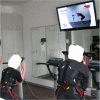Whole-body electromyostimulation as a means to impact muscle mass and abdominal body fat in lean, sedentary, older female adults: subanalysis of the TEST-III trial
- PMID: 24130433
- PMCID: PMC3795534
- DOI: 10.2147/CIA.S52337
Whole-body electromyostimulation as a means to impact muscle mass and abdominal body fat in lean, sedentary, older female adults: subanalysis of the TEST-III trial
Abstract
Background: The primary aim of this study was to determine the effect of 12 months of whole-body electromyostimulation (WB-EMS) exercise on appendicular muscle mass and abdominal fat mass in subjects specifically at risk for sarcopenia and abdominal obesity, but unable or unwilling to exercise conventionally.
Methods: Forty-six lean, nonsportive (<60 minutes of exercise per week), elderly women (aged 75 ± 4 years) with abdominal obesity according to International Diabetes Federation criteria were randomly assigned to either a WB-EMS group (n=23) which performed 18 minutes of intermittent, bipolar WB-EMS (85 Hz) three sessions in 14 days or an "active" control group (n=23). Whole-body and regional body composition was assessed by dual energy X-ray absorptiometry to determine appendicular muscle mass, upper leg muscle mass, abdominal fat mass, and upper leg fat mass. Maximum strength of the leg extensors was determined isometrically by force plates.
Results: After 12 months, significant intergroup differences were detected for the primary end-points of appendicular muscle mass (0.5% ± 2.0% for the WB-EMS group versus -0.8% ± 2.0% for the control group, P=0.025) and abdominal fat mass (-1.2% ± 5.9% for the WB-EMS group versus 2.4% ± 5.8% for the control group, P=0.038). Further, upper leg lean muscle mass changed favorably in the WB-EMS group (0.5% ± 2.5% versus -0.9% ± 1.9%, in the control group, P=0.033), while effects for upper leg fat mass were borderline nonsignificant (-0.8% ± 3.5% for the WB-EMS group versus 1.0% ± 2.6% for the control group, P=0.050). With respect to functional parameters, the effects for leg extensor strength were again significant, with more favorable changes in the WB-EMS group (9.1% ± 11.2% versus 1.0% ± 8.1% in the control group, P=0.010).
Conclusion: In summary, WB-EMS showed positive effects on the parameters of sarcopenia and regional fat accumulation. Further, considering the good acceptance of this technology by this nonsportive elderly cohort at risk for sarcopenia and abdominal obesity, WB-EMS may be a less off-putting alternative to impact appendicular muscle mass and abdominal fat mass, at least for subjects unwilling or unable to exercise conventionally.
Keywords: abdominal fat; aged; electrostimulation; exercise; muscle; sarcopenia.
Figures



Similar articles
-
Impact of whole-body electromyostimulation on body composition in elderly women at risk for sarcopenia: the Training and ElectroStimulation Trial (TEST-III).Age (Dordr). 2014 Feb;36(1):395-406. doi: 10.1007/s11357-013-9575-2. Epub 2013 Aug 16. Age (Dordr). 2014. PMID: 23949160 Free PMC article. Clinical Trial.
-
Whole-body electromyostimulation and protein supplementation favorably affect sarcopenic obesity in community-dwelling older men at risk: the randomized controlled FranSO study.Clin Interv Aging. 2017 Sep 21;12:1503-1513. doi: 10.2147/CIA.S137987. eCollection 2017. Clin Interv Aging. 2017. PMID: 28989278 Free PMC article. Clinical Trial.
-
Effects of Combined Whole-Body Electromyostimulation and Protein Supplementation on Local and Overall Muscle/Fat Distribution in Older Men with Sarcopenic Obesity: The Randomized Controlled Franconia Sarcopenic Obesity (FranSO) Study.Calcif Tissue Int. 2018 Sep;103(3):266-277. doi: 10.1007/s00223-018-0424-2. Epub 2018 Apr 19. Calcif Tissue Int. 2018. PMID: 29675640 Clinical Trial.
-
Efficacy of Whole-Body Electromyostimulation (WB-EMS) on Body Composition and Muscle Strength in Non-athletic Adults. A Systematic Review and Meta-Analysis.Front Physiol. 2021 Feb 26;12:640657. doi: 10.3389/fphys.2021.640657. eCollection 2021. Front Physiol. 2021. PMID: 33716787 Free PMC article.
-
Effects of Whole-Body Electromyostimulation on Strength-, Sprint-, and Jump Performance in Moderately Trained Young Adults: A Mini-Meta-Analysis of Five Homogenous RCTs of Our Work Group.Front Physiol. 2019 Nov 8;10:1336. doi: 10.3389/fphys.2019.01336. eCollection 2019. Front Physiol. 2019. PMID: 31780950 Free PMC article.
Cited by
-
Higher Impulse Electromyostimulation Contributes to Psychological Satisfaction and Physical Development in Healthy Men.Medicina (Kaunas). 2021 Feb 25;57(3):191. doi: 10.3390/medicina57030191. Medicina (Kaunas). 2021. PMID: 33668740 Free PMC article.
-
Can the use of photobiomodulation for localized fat reduction induce changes in lipid profile? A critical integrative review.Lasers Med Sci. 2022 Dec 24;38(1):23. doi: 10.1007/s10103-022-03662-5. Lasers Med Sci. 2022. PMID: 36564660 Review.
-
Efficacy and Safety of Low Frequency Whole-Body Electromyostimulation (WB-EMS) to Improve Health-Related Outcomes in Non-athletic Adults. A Systematic Review.Front Physiol. 2018 May 23;9:573. doi: 10.3389/fphys.2018.00573. eCollection 2018. Front Physiol. 2018. PMID: 29875684 Free PMC article.
-
Effects of whole-body electromyostimulation on function, muscle mass, strength, social participation, and falls-efficacy in older people: A randomized trial protocol.PLoS One. 2021 Jan 25;16(1):e0245809. doi: 10.1371/journal.pone.0245809. eCollection 2021. PLoS One. 2021. PMID: 33493160 Free PMC article. Clinical Trial.
-
The Influence of Physical Training on Breast Cancer: The Role of Exercise-Induced Myokines in Regulating Breast Cancer Cell Growth and Survival.Int J Mol Sci. 2024 Oct 23;25(21):11379. doi: 10.3390/ijms252111379. Int J Mol Sci. 2024. PMID: 39518934 Free PMC article.
References
-
- Slentz CA, Aiken LB, Houmard JA, et al. Inactivity, exercise, and visceral fat. STRRIDE: a randomized, controlled study of exercise intensity and amount. J Appl Physiol. 2005;99(4):1613–1618. - PubMed
-
- Latham N, Anderson C, Bennett D, et al. Progressive resistance strength training for physical disability in older people. Cochrane Database Syst Rev. 2003;2:CD002759. - PubMed
Publication types
MeSH terms
LinkOut - more resources
Full Text Sources
Other Literature Sources
Medical

